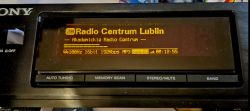

Czy wolisz polską wersję strony elektroda?
Nie, dziękuję Przekieruj mnie tamrobgold wrote:.Generally, I sometimes get the impression that this radio is not about having a radio but about having entertainment for winter days by writing soft. just having a radio is like a side effect
 .
.

 .
.
robgold wrote:.In the first option at TRUE by turning the encoder you change the volume and by clicking you get the station list, at FALSE by turning the encoder you change the station list and by clicking you adjust the volume.
DJCheester wrote:the yellow OLED matches the retro hardware.
wirbud wrote:BLWIP-FIX.ZIP 2. Unzip and copy liblwip.a to the directory (you have a username, hardware version may be different): C:UsersAppDataLocalArduino15packages32hardwareespesp322.0.17tools.liblwip.a - for ESP32 or C:UsersAppDataLocalArduino15packages32hardwareesp322.0.
Hello so I only need the archive liblwip-fix.zip ?
This second file is unnecessary ? liblwip_20241019_3.0.5 ?
With me I have the 2.0.17 version of ESP libraries and in both the first ESP32 link and the second ESP32S3 link I already have the liblwip.a file but they are not the same in S3 takes more ?
Then what should I replace with this Fix file in the two cases ?
And one more question, because on the second computer I have a version of the library 3.1.1 (on 64bit), should I also replace there the same liblwip.a file with this fix ?
Greetings ...
Added after 16 [minutes]: .
Hello again on my second computer I have Win7 64Bit and Arduino 2.1.1 and ESP 3.1.1 libraries
And there is no such folder there anymore
C:UsersAppDataLocalArduino15packages32hardware2.0.17tools32.1.
C:\Users\user\AppData\Local\Arduino15\packages\esp32\hardware\esp32\2.0.17\tools\sdk\esp32s3\lib\
After version 3.1.1 there are tools and then there is just this
.
Greetings ...
Added after 7 [minutes]:hevet wrote:.If anyone fancies the code without encoders and player then please Link.
You should also swap the Audio library with mine, as I've extended the equalizer range from -40 to +12.
Version @robgold
With this firmware, should I replace the library attached in this file with the original robgold one ???
What does it do, does it improve anything ??
And lastly, as robgold's software is updated all the time (as long as it's not difficult to do so), could you tell me what needs to be changed in the software to get rid of the encoder completely ???
This is so that you can make the changes yourself - as long as it is not a very complicated operation ??
Best regards ...